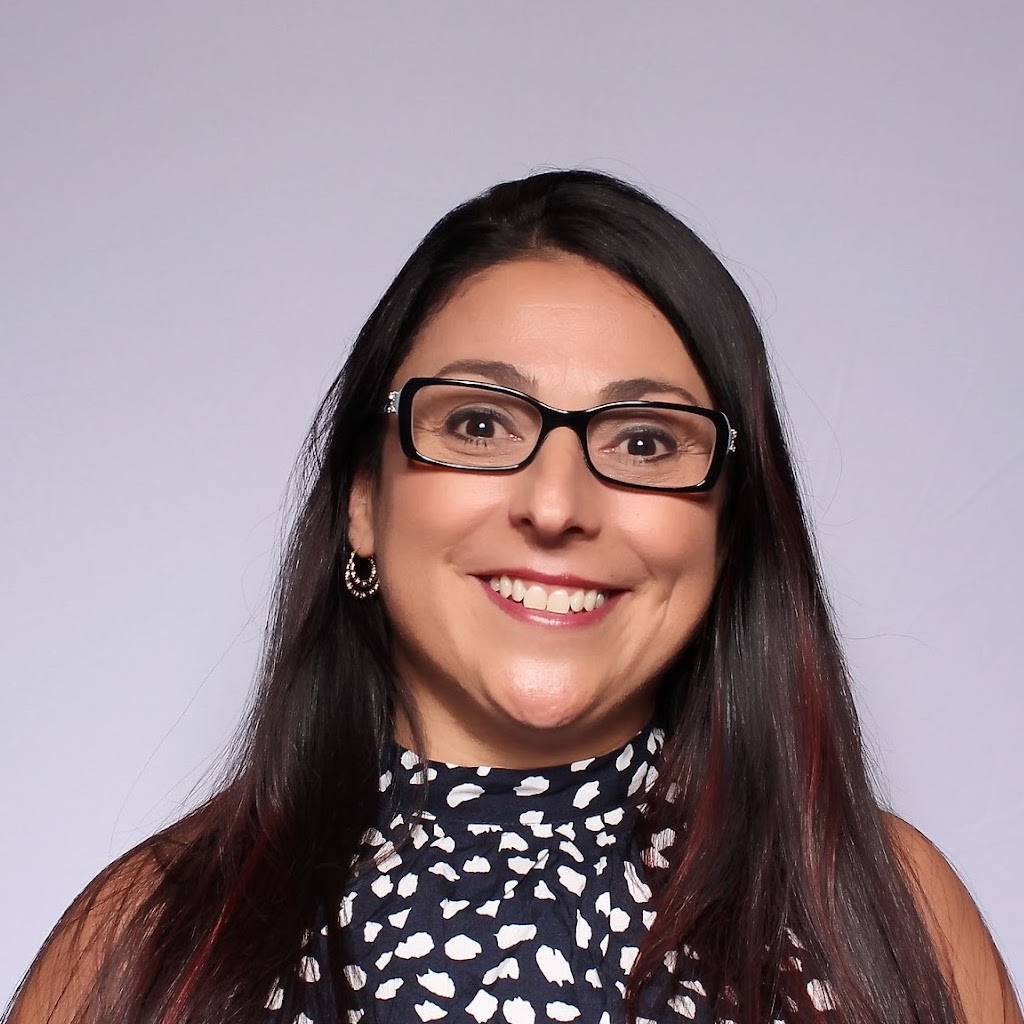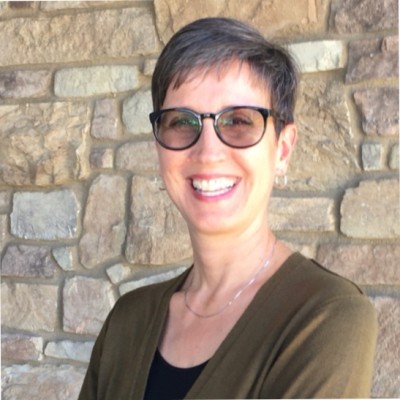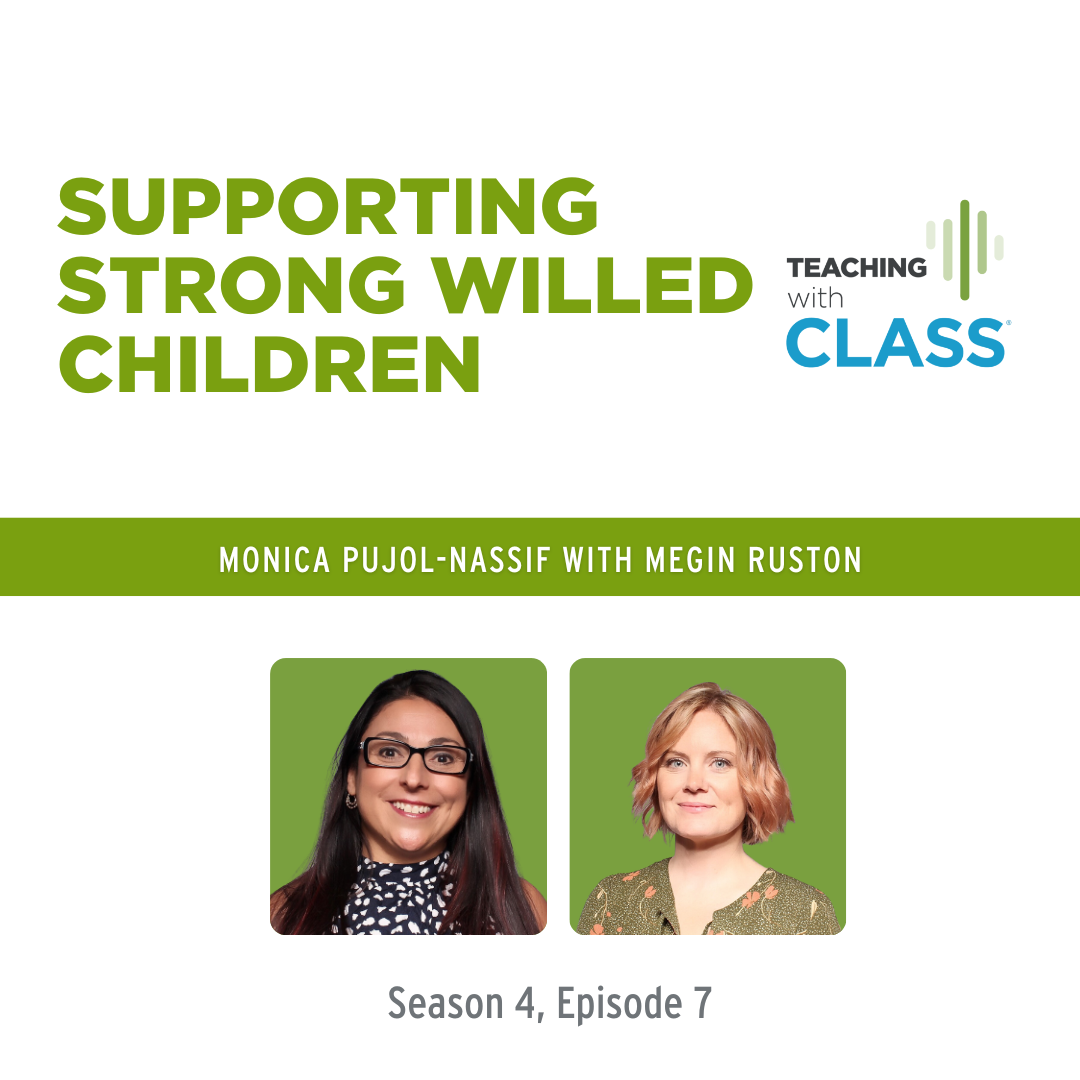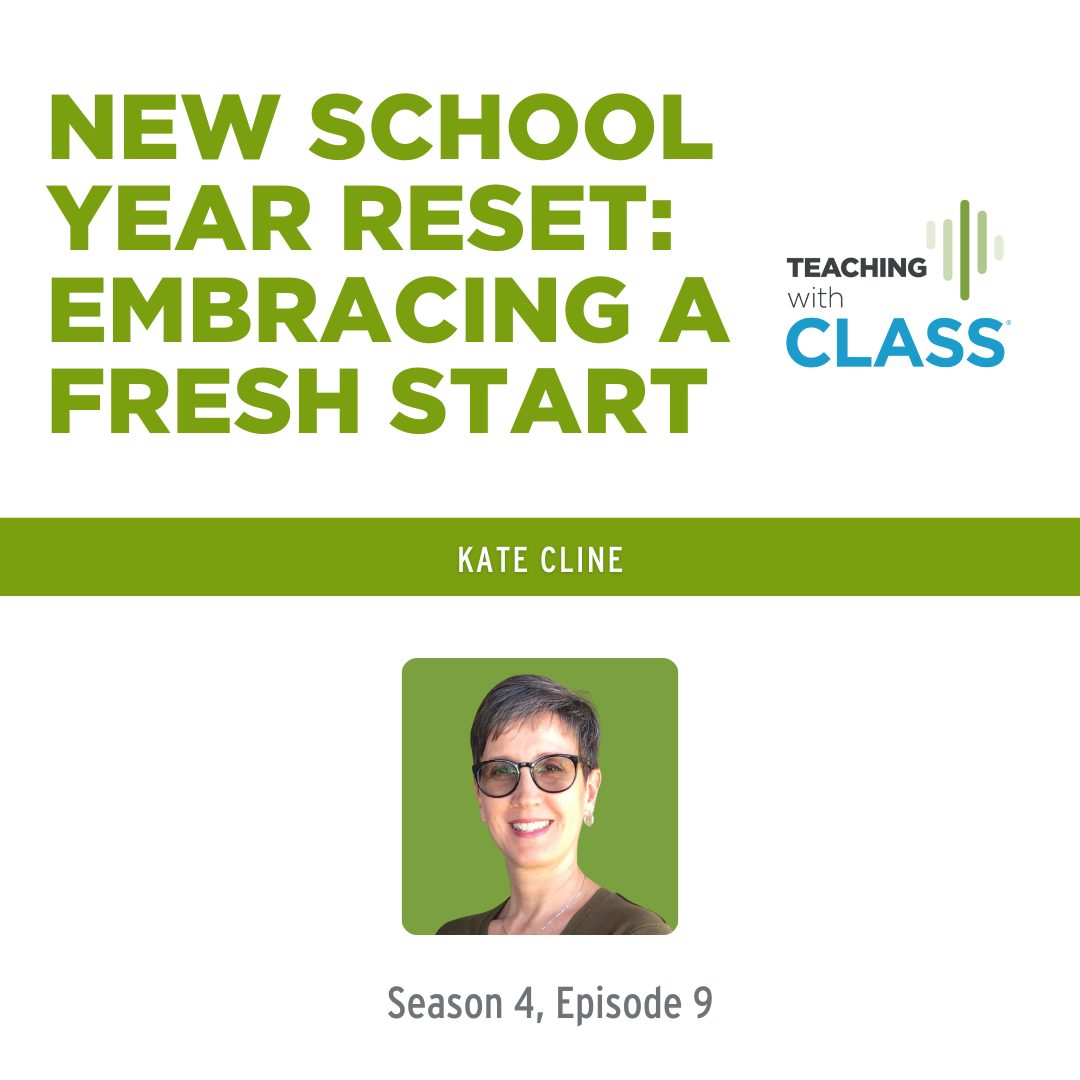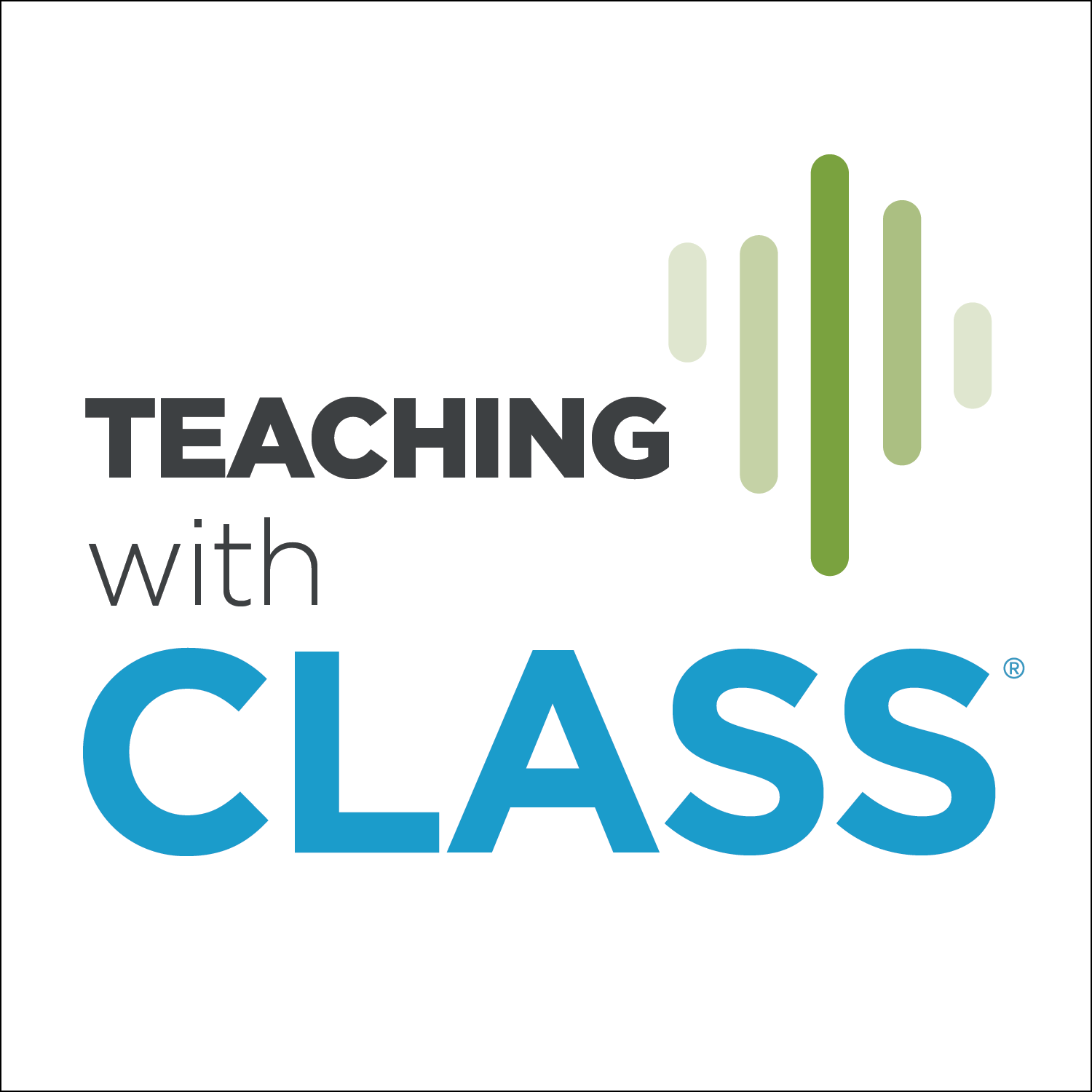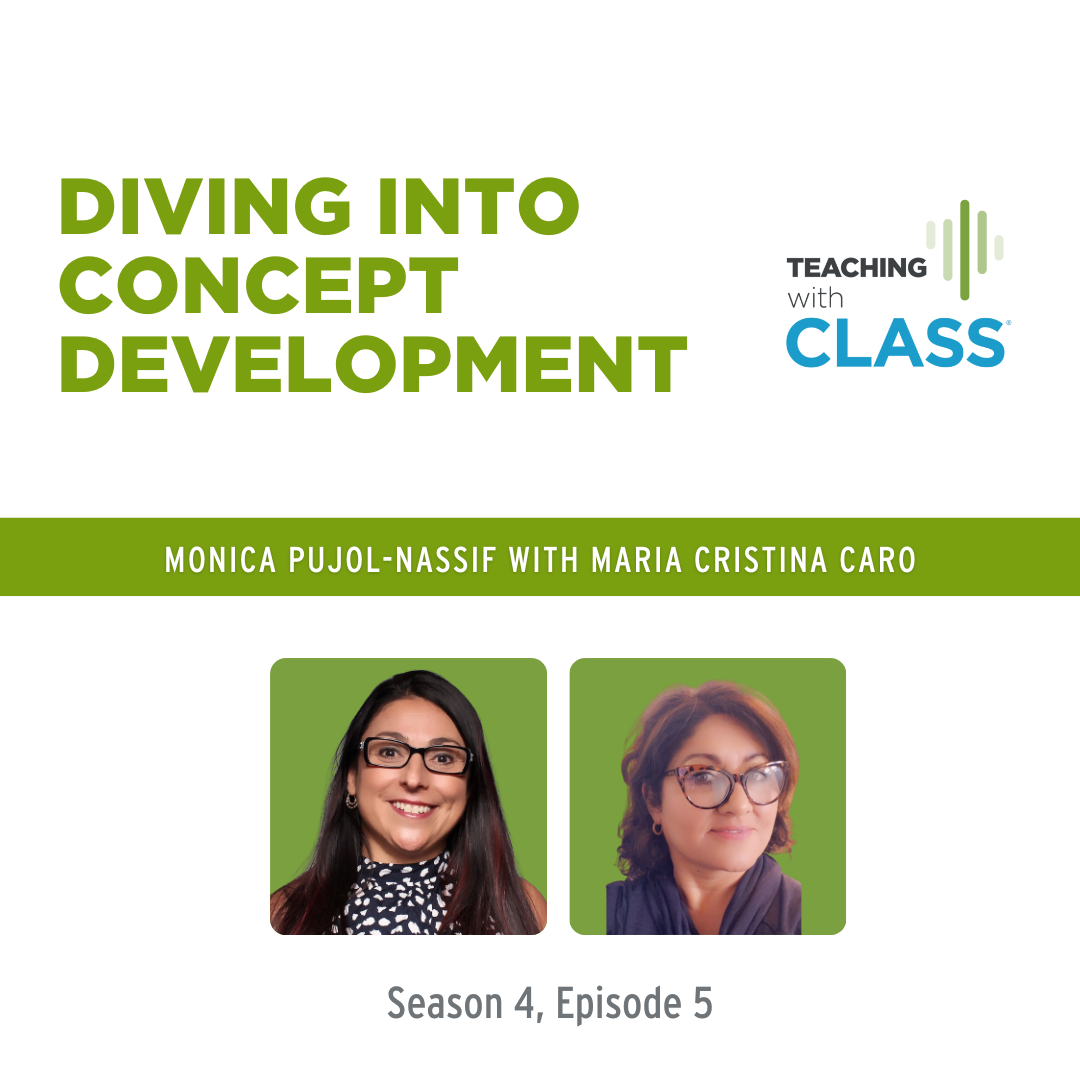Episode Transcript
Monica: Hello, everyone. Welcome to the Teaching with CLASS podcast, the podcast that gives you quick, actionable tips to easily implement in your classroom. I'm your host, Monica Pujol-Nassif. Today's episode, we're going to be talking about creating a culture of belonging.
With us today, we have Pamela Thompson. Welcome, Pamela. She is a Director of Teaching and Learning at Neighborhood Villages in Boston. Welcome. We're super happy to have you.
Pamela: Thanks so much. I'm really excited to be here.
Monica: Tell us a little bit about you, Pamela.
Pamela: I am a lifelong early childhood person. My mother is also an early childhood educator. I was basically born into the classroom. There's a picture of me of my first visit to the classroom, I was three months old. I basically never left. It's been a whirlwind of a career.
I have the privilege of working with a small nonprofit in Boston, as you mentioned, Neighborhood Villages, that is working to realize a world in which every child and family has access to high quality, affordable early childhood education. In my role, I work with five independent partner early childhood programs that we call the Neighborhood.
I get the opportunity to work directly with educators, as well as administrators to meet their needs in the classroom every day to make sure that we are finding out what professional development they're looking for, finding out what things are difficult for them in the classroom, and then helping them through coaching, and through professional development opportunities and experiences.
I've been a teacher myself. I was a preschool teacher, I was a supervisor, I've been a program director, I've been a coach, really loving being with children and being with educators on a daily basis is right here.
Monica: Thank you, Pamela. I love how you say, I've been an educator. From that, that's where our heart lives. We're all educators. Whatever role you have today supporting those educators, so that those children get the best quality of experiences in their settings.
Pamela: Absolutely.
Monica: One of the magical moments of today's episode is we're going to be addressing educators of toddlers, children from 15 months old to 36 months of age within the CLASS tool. Pamela is going to try to put herself in her shoes as the educator that she is and she's been, and also as the person who supports educators across her grant.
The first question is, you said your mom was in early childhood, and then you never left the classroom. What was that drive that kept you in the classroom?
Pamela: It's the children. It is the joy that I get to see on their faces when they have aha moments, when they figure something out, when they try something new for the first time. Then it morphed into the joy on educators' faces when they see a child figure something out, when they see a child take a risk and do something for the first time, when they have an epiphany moment of, I've tried this way for so long, and then I had this conversation with my coach, and I moved to this thing, and oh, my goodness, what a difference it made, and helping them to see the impact that they really have especially in a toddler classroom. That's what keeps me going, those little smiles and those big smiles of just joy.
Monica: Beautiful. I so connect with you there. When we were talking, you mentioned the importance of working with families. Can you tell us a little bit about how you involve families in the classroom to create a strong partnership between parents and educators?
Pamela: I think this is one thing that is of utmost importance when our little people are so little. In this country and around the world, we know that as children grow and age, families are less and less and less involved, and they're less and less and less engaged, two different things. Involve knowing what's going on and sharing a little bit of information, engaged part of the classroom, part of the learning, extending the learning in their home space. Involvement, engagement, two very different things.
When we're talking about how are we involving and engaging our families and what their children are learning and experiencing on a daily basis, we're doing things like doing our homework. Getting to know that family, and saying in so many words, I value you and your contributions to this community of our classroom. Saying to them, maybe they don't speak English, what is it that I'm doing to make sure that I can help them feel welcome and help them feel like they belong, that their child belongs here?
If I have a child who speaks Hindi, am I trying to find a way to ask the parent to teach me how to say hello in Hindi? Am I doing a little bit of homework, which takes time, and we know that educators don't have a lot of it. But these little things, asking a family, how do I say, good morning? How do I say, you're doing a wonderful job? How do I say, come wash your hands? How are we reflecting that in the classroom?
That first initial interaction that we have with families is so crucial to how their child thrives and how they thrive as a family, so making sure that we're asking those simple, simple questions. Can you just share with me? In changing our vernacular, that's one thing that I did as an educator.
When I was in the classroom, I was not saying, I need to know how to say hello. Okay, sure. But if I went to a family and I said, listen. I noticed that they respond much better when you speak to them in Hindi, I was wondering, could you share with me how to say certain things so that they know that they belong here?
Can you share with me? It's an invitation. It's not a, I need to know so that I can make sure that they are paying attention. No. It's an invitation into the community and the family that becomes this classroom.
How do I involve families in the classroom? It's an invitation. I offer multiple ways for families to enter that space. Is it sharing language? Is it sharing a book? Is it coming in and spending time in the room if they are available? Is it they are bringing in materials for us to use in our learning experiences? Are we inviting in multiple ways, families to meet us where they are?
I'm not asking families. I'm not asking all families to do the same thing because I know that their capacity is different. I know that their experience is different. I know that what they have to offer might be different. When I do that, those families that feel nervous or scared, they're new to the country, they're new to the city, they're new to this thing called childcare. When I do that, I say to them, whatever you have to offer is valuable and is going to elevate our classroom together. So really, an invitation.
Monica: The second to mind, a specific moment of a specific child with the family that you experienced, that you can share with us. I should talk. I just go back to my life as a teacher.
Pamela: There are so many. I live in Boston. We have a very diverse population in Boston, and it is ever changing. The example of Hindi is actually really recent. We have a family that speaks Hindi in one of my programs. We have a family that speaks Farsi. Nobody speaks Farsi in our program, so we are trying, and I'm supporting the educators to do this.
The grown-ups of the family, and I say grown-ups because we don't know if they are the parent, so you'll hear me say grown-up, not necessarily parent. Again, that was a change that I made when I'm thinking about inviting the whole family into the classroom, changing it to, oh, you're grown-up. Yeah, that's your grown-up because I don't know if it's mom or dad because I haven't done my homework yet. I don't know if it's grandma, I don't know if it's auntie, I don't know if it's a foster mother. I don't know, so I use the term grown-up.
We currently have this family that speaks Farsi and another family that speaks Hindi. We don't have anybody who speak those languages, so we are trying to bridge that gap with those families. The grown-ups do speak a little bit of English and helping. Google Translate is a great thing. Sometimes it's wrong, but it's a great tool to use when you're trying to build that relationship because what you're saying to them is hearing your voice matters to me.
It's not just, oh, you speak another language, I can't talk to you. It's, oh, I don't speak your language. Your child doesn't speak our language. What am I doing to help them acclimate to this classroom while still being very respectful of what happens in your home?
We talk about consistently welcoming children to the classroom in early childhood because we know, typically, early childhood is 52 weeks a year. We are constantly having children age in and age out of our classrooms. Doing this consistently is really, really important.
We have this child—it's the middle of the school year, it was in the spring—who's coming to this country, coming to a classroom for the first time, has never really heard English, and really thinking about, what are the steps that I'm helping educators to take to meet that family and meet that child where they are? And really, again, invite them into the space.
Monica: When you use Google Translate—by the way, I think it's an amazing resource. It's right there, everybody can use it—were you there to see the response from the child when the teachers use it?
Pamela: I wasn't. Unfortunately, I wasn't in that day, but I did speak with them afterwards. They used Google Translate in conversation with the parent. They attempted to say it. The story that I got, the parent was like, oh, like shocked that they tried, that this teacher is trying to speak a word that the child would recognize.
She said that they were shocked that she tried in the moment. When she did try, she was slightly off, so they said it back to her. There was this nice back and forth with her getting the pronunciation correct. I don't think the child was there at the moment. The next morning, when the child came in and she said it, she said, the child's face—I know, I’m getting emotional—was just like, wow. Okay, I just got chills, like oh, you care about me. This is a toddler. This isn’t even a pre-schooler. This is a toddler. And the toddler was just like ba-ba-ba-ba-ba-ba-ba-ba, and started babbling back to her.
Monica: As you were talking, you were talking about how this is going to enhance those learning experiences. Speaking about that sense of belonging, how will that help children feel safe so that they can dive into that learning experience?
Pamela: Think about it. As an adult, if somebody uses your requested name, we know that people shorten names sometimes, or they're called something different growing up. For instance, me, I was called Pam growing up, and then I started my career and I was introduced as Pamela, and I became Pamela. Getting used to being called Pamela and that respect that's there.
We're building that positive climate. We're showing that respect for children and families by using their own language, by using their name, by using familiar phrases or gestures that they might know, making sure that I'm giving specific and individualized feedback. Quality feedback. Making sure I'm giving those directly at that child, so not that good job. Oh, good job, [...]. No. Oh, Monica, what a wonderful time you had outside on the playground today. I can't wait to see what you do tomorrow.
Really affirming each child, really making sure that we're taking the time to say, I see you and here's how. I see you, I hear you, I'm here for you. How can I help you to engage in whatever this is? You call them learning experiences. Thank you so much, I'm so excited.
Again, when I mentioned the change of language that I've used as an educator, that's something that I changed. From activities to learning experiences. Activities is when we hear everybody does the same thing, and they all look the same. That's the product.
Learning experiences. If we help educators to think about what they're doing in the classroom and what they're presenting to children in the classroom as learning experiences. These children will have the opportunity to engage in something and they are learning, it changes how we approach it. We turn into this.
This is something I tell the educators I work with all the time. How are we shifting into a yes environment? When I say yes to a child, I'm giving them autonomy, I'm giving them choice. I'm giving them the freedom and the flexibility to engage with materials in front of them, on the playground, at the park, or wherever we are. I'm giving them the opportunity to take it where they want to go in regard for child perspective.
I'm giving them the opportunity to show me what they are interested in, what they want to learn. By doing that, again, I'm showing them that I value and respect what they have to bring to this classroom. If I am constantly controlling everything, if I'm constantly keeping this box, this rectangle happening, children aren't going to engage. They aren't going to say to themselves, toddlers babbling.
They're not going to pick something new up and explore that because I'm telling them no, they can't. How am I turning it into a yes environment? How am I saying, yeah, go right ahead, dump all the markers on the floor, that's right, what are we going to create? Let's go. How am I building that risk taking through how I facilitate what they're doing?
Monica: Yes environment, it's that why not.
Pamela: Yeah, why not?
Monica: Why not do it in that way? Let's expand on that.
Pamela: All right.
Monica: This is an encouragement for children to explore. Where does the teacher go from there? Now it's that attitude of yes, let's do it. Let's explore, let's manipulate, let's learn. What can a teacher do to guide, to facilitate a moment of learning?
Pamela: First and foremost, ask questions. We say this all the time when we're talking about CLASS. What are the questions being asked? Are we asking open-ended questions? And yes, to toddlers. What are we saying to toddlers? Yes, they do not understand, they do not have a lot of expressive language. But we need to remember that children's brains between birth and five are 90% developed.
How am I saying yes to what they're doing and then taking that, like you're saying, and guiding what they're doing because I'm paying attention? If they pick up the dinosaurs, I'm going to say, ooh, I wonder how dinosaurs used to walk. Just those questions that we're asking.
We're using vocabulary. Oh, that's a brontosaurus. Can you say that? That's a brontosaurus. I see in my work that sometimes educators, especially toddler educators, are nervous about using big vocabulary. They're nervous about using big sentences. They tend to stay here with their language because it's what children understand right now.
I help to encourage them to use this language, because what happens if? What happens if you use the word brontosaurus repeatedly in your dinosaur exploration? They're going to start using that word. It might sound like [...] because they're toddlers, but they're trying. Are we giving them the opportunity to try these new words? Are we using big sentences, full sentences?
Are we asking them, I wonder how, can you show me what you mean by that? Oh, how did you decide to use the purple and the blue in your painting? How are we asking those questions to expand their cognition? Are we asking those questions to make the connections between what we learned last week and what we're learning today? Are we expanding what they're saying? Are we adding more information?
When a child says, book, are we saying yes, that is a very large book. Remember, we read that one, and it had all these pictures of the tyrannosaurus rex and the triceratops. Do you remember when we talked about that? You know what? I think we have those over here. Do you want to go find them? Are we giving that opportunity to take this and do this with it?
Monica: I'm just going to describe what you just did in case you're listening to us and you're not seeing the video. Pamela made a small square with her fingers, and then she expanded that square with her arms. Something small to something infinite. It's endless.
Pamela: It really is endless. Part of my job is to empower educators, to know what you're doing in the classroom. You know how to follow a child's lead. You know how to do that. And now my job is to help you go that extra step like you were just talking about.
It's to get you to ask the question that might feel silly in the moment because they're one-and-a-half. It might feel weird for you to ask a 19-month-old, how did you decide? I challenge all of you listening to do that and see what happens. See the response that you get from the child. Watch their face. Watch their physical demeanor change. See how that question impacts the next thing that they do.
Monica: You just spoke about the depth of that interaction. I love it. Just building on what you're saying, how would you encourage children's confidence? How would you celebrate them when they are giving those steps in their learning experience?
Pamela: I mentioned earlier, I think I said something about when a child does something that you've been helping them learn. Maybe it's putting something away successfully on their own, like cleaning up. Perhaps you've been working on cleaning up for a couple of weeks with this child, maybe five weeks. Who knows? And then they do it.
What is our response to that? They do it on their own. You don't have to ask. You say, oh, guys, it's time for clean-up so we can get ready to go outside. And they do it. Number one, are you paying attention because you saw it? Did you see it?
Number two, when you saw it, what is your response? Is it, oh, good job, Monica. Thank you for putting that away. Or is it a volcano? Is it a volcano of an eruption of excitement for what that child just did for the first time on their own that you have been working with?
Is it, oh, thank you so much, Monica, for putting that away, I'm so proud of you. Or is it, oh, Monica. You did it. You put it away on your own, I am so proud of you. And then you pull your co-teacher in. Miss so and so, did you see Monica put it away by herself, she got it up on the shelf? I'm so proud of you, high five. Are we erupting in positive emotion and building that child up?
This is also really important when we do that. We need to pay attention to the child's response again. Do they shrink because I gave them too much? Or do they also get hype and are like, yeah, I did do it. It is a delicate balance. It's trial and error.
By this point, when you're doing that, because you've done your homework to know the children in your room, you know what is going to be best for them. You know what response from you and your co-teacher, teachers preferably, that that big response is not going to work for them. Perhaps it's the response where you go over and you get down on your knee, and you look them right in the eye if that's culturally responsive. If it is not, eye contact is a big thing.
Are you on their level and you say to them, I saw you got that all by yourself. I am so proud of you. I can't wait for you to be able to do the next thing. Emotion. It's the kids. I can see it happening in the room. That's why I keep doing what I do.
Knowing that that particular child needs this big response from me and this other child needs a one-on-one response. Again, doing our homework to know what that child needs from us as an educator is really important. It might take time for you to find that out. You have a new child in your room, and you give this big response, and they get this scared face there and you're like, oh, I'm so sorry. But now you've learned that that's not what that child needs.
Even though it's not this huge response, is it the response the child needs? Is it the response that is going to help the child to continue to take “risks” in your classroom? I say “risks” because we think of risk as risky play and falling off of something. No. Taking risks is, I'm going to try something new. I'm going to put my finger in the paint today because that feels weird to me. That's a risk for a toddler, taking that step to try something new.
Thinking about, is my response appropriate? Is it responsive to what that child has already experienced? This goes back to talking with the family about how you celebrate your child at home. How do you show that you're excited about something that your child has done? I want to make sure that I reflect that.
Monica: Wonderful, relatable information. Thank you so much. I can imagine. I can visualize those teachers and say, oh, my goodness. That's my child. That's the family I work with. Will you share a couple of takeaways for teachers to go and implement right away in the practice?
Pamela: Absolutely. You've heard me say a couple of times, do your homework. Absolutely. Please take the time. Even if it is five minutes to speak to, perhaps, the family navigator that has worked with the family. Perhaps if there is a social worker involved, have you had the opportunity? Even if it's just an email interaction to really try and take time to learn as much as you can about children coming into your room, getting to know the grown ups that are engaged in their lives.
We know that a lot of cultures have extended family in the home. A lot of families that we have now have mom and dad, mom and mom, or dad and dad. They have auntie, they have grandma, they have great grandma. They've got this whole massive nuclear family that is involved and engaged with this child. Take the time to learn as much as you can.
Again, it might take time, and that's okay. As long as you are putting in that effort to show that you value and respect everything that that family has to bring to your classroom. It's invaluable. It really is. It really absolutely is.
Number two is like we were just talking about, helping children to feel safe to jump into learning experiences. When I talk with educators, what I talked to them about a lot is think about what you're putting out for children. What are the materials that you're putting in front of them? What is the experience that you're setting up for them to engage in?
Again, I talked about inviting families. How are you inviting children to engage in that experience? How are you facilitating their introduction to a new material in your classroom? Thinking about, oh, I'm going to put out sticks, natural materials, and thinking about, am I right there when I do that?
Am I right there to talk about the bark, the length, and the thickness, of this piece of nature in front of them? If I said, oh, would you like to explore this with me, again, that invitation. I would encourage educators to invite children to whatever it is that is being put out.
Finally, I would say—I say it all the time to the educators I work with, and I'm going to try not to get emotional because this is deeply what I believe—you educators, especially of infants and toddlers, I need you to recognize the role that you play in children's lives and the impact that you have.
Even if you feel so overwhelmed, so overworked, and so rundown, I want you to take five minutes, at the end of your day, at the beginning of your day, at your lunch break, to reflect on what you do and say with children, and how much that impacts their lives not only right now, not only what we see tomorrow, but I want you to think about how that impacts their lives for the rest of their schooling and into their professional career. I want you to think about the fact that the words that you say today, tomorrow, and next week, children remember those.
Children remember how you made them feel. Children remember that teacher. Even as a toddler, children remember that teacher. You are that teacher every day for the children in your classroom. I need you to remember how crucial you are to children's development. Just two minutes in those hard moments with toddlers, in those hard moments when children are having a tantrum, having a meltdown, because something has happened.
Remember, they don't have the expressive language to tell you. When that's over, remember that how you responded to that and helps them move through that emotion, has had a massive impact on their brain development, their social development, and their ability to be amazing, fabulous human beings that they are.
Monica: I'm not going to add anything to that because you had me in tears too. A hundred percent, teachers of infants and toddlers have the most important time of the life of a human being. You mentioned 90% of the brain is ready by age five. Seventy-five percent of that brain is grown by age three. Those are the children that you have.
With this, Pamela, I want to thank you for being here, for being so generous with your time, for sharing your expertise, your stories, stories of your teachers. For you teachers out there, you can find this episode and the transcript on our website at teachstone.com/podcasts.
I want to thank you, architects of the brain, architects of the mind, for sharing your love and wisdom with the children of the world and for being here to add to your books of wonders. I'll see you next time. Bye-bye.

